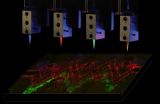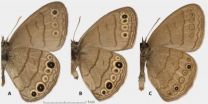(Press-News.org) New technology to capture the kinetic energy of our everyday movements, such as walking, and to convert it into electrical energy has come a step closer thanks to research to be published in the International Journal Biomechatronics and Biomedical Robotics.
Researchers have for many years attempted to harvest energy from our everyday movements to allow us to trickle charge electronic devices while we are walking without the need for expensive and cumbersome gadgets such as solar panels or hand-cranked chargers. Lightweight devices are limited in the voltage that they can produce from our low-frequency movements to a few millivolts. However, this is not sufficient to drive electrons through a semiconductor diode so that a direct current can be tapped off and used to charge a device, even a low-power medical implant, for instance.
Now, Jiayang Song and Kean Aw of The University of Auckland, New Zealand, have built an energy harvester that consists of a snake-shapes strip of silicone, polydimethylsiloxane, this acts as a flexible cantilever that bends back and forth with body movements. The cantilever is attached to a conducting metal coil with a strong neodymium, NdFeB, magnet inside, all enclosed in a polymer casing. When a conductor moves through a magnetic field a current is induced in the conductor. This has been the basis of electrical generation in power stations, dynamos and other such systems since the discovery of the effect in the nineteenth century. Using a powerful magnet and a conducting coil with lots of turns means a higher voltage can be produced.
In order to extract the electricity generated, there is a need to include special circuitry that takes only the positive voltage and passes it along to a rechargeable battery. In previous work, this circuitry includes a rectifying diode that allows current to flow in one positive direction only and blocks the reverse, negative, current. Unfortunately, the development of kinetic chargers has been stymied by current diode technology that requires a voltage of around 200 millivolts to drive a current.
Song and Aw have now side-stepped this obstacle by using a tiny electrical transformer and a capacitor, which acts like a microelectronic battery. Their charger weighing just a few grams oscillates, wiggling the coil back and forth through the neodymium magnetic field and produces 40 millivolts. The transformer captures this voltage and stores up the charge in the capacitor in fractions of a second. Once the capacitor is full it discharges sending a positive pulse to the rechargeable battery, thus acting as its own rectifier.
The team concedes that this is just the first step towards a viable trickle charger that could be used to keep medical devices, monitors and sensors trickle charged while a person goes about their normal lives without the need for access to a power supply. The system might be even more useful if it were embedded in an implanted medical device to prolong battery life without the need for repeated surgical intervention to replace a discharged battery. This could be a boon for children requiring a future generation of implanted, electronic diagnostic and therapeutic units.
INFORMATION:
"An energy harvester from human vibrational kinetic energy for wearable biomedical devices" in Int. J. Biomechatronics and Biomedical Robotics, 2014, 3, 54-61
Kinetic battery chargers get a boost
2014-02-19
ELSE PRESS RELEASES FROM THIS DATE:
A*STAR scientists discover protein's role in human memory and learning functions
2014-02-19
1. Scientists at A*STAR's Institute of Molecular and Cell Biology (IMCB) have identified the precise role of the protein, SNX27, in the pathway leading to memory and learning impairment. The study broadens the understanding of the brain's memory function and could be used to explain defects in the cognitive development of those with Down's syndrome. The newly established knowledge could potentially facilitate exploration of strategies to improve memory and learning abilities in Down's syndrome.
2. Down's syndrome is a genetic condition characterized by the presence ...
Could metabolism play a role in epilepsy?
2014-02-19
VIDEO:
The Kuehner lab demonstrates their drug-screening technique in JoVE's peer-reviewed video format to aid other researchers in the field.
Click here for more information.
February 19—Researchers from the Franciscan University of Steubenville, Ohio are exploring a possible link between metabolic defects and seizures. They determined that diet could influence susceptibility to seizures, and they have identified a common diabetes drug that could be useful in treating disorders ...
An essential step toward printing living tissues
2014-02-19
BOSTON — A new bioprinting method developed at the Wyss Institute for Biologically Inspired Engineering at Harvard University and the Harvard School of Engineering and Applied Sciences (SEAS) creates intricately patterned 3D tissue constructs with multiple types of cells and tiny blood vessels. The work represents a major step toward a longstanding goal of tissue engineers: creating human tissue constructs realistic enough to test drug safety and effectiveness.
The method also represents an early but important step toward building fully functional replacements for injured ...
Antidepressant holds promise in treating Alzheimer's agitation
2014-02-19
Feb. 19, 2014 (Toronto) - An antidepressant medication has shown potential in treating symptoms of agitation that occur with Alzheimer's disease and in alleviating caregivers' stress, according to a multi-site U.S.- Canada study.
"Up to 90 per cent of people with dementia experience symptoms of agitation such as emotional distress, restlessness, aggression or irritability, which is upsetting for patients and places a huge burden on their caregivers," said Dr. Bruce G. Pollock, Vice President of Research at the Centre for Addiction and Mental Health (CAMH), who directed ...
'Beautiful but sad' music can help people feel better
2014-02-19
New research from psychologists at the universities of Kent and Limerick has found that music that is felt to be 'beautiful but sad' can help people feel better when they're feeling blue.
The research investigated the effects of what the researchers described as Self-Identified Sad Music (SISM) on people's moods, paying particular attention to their reasons for choosing a particular piece of music when they were experiencing sadness - and the effect it had on them.
The study identified a number of motives for sad people to select a particular piece of music they perceive ...
Stratification determines the fate of fish stocks in the Baltic Sea
2014-02-19
With its narrow connection to the North Sea, strong currents, a large number of river estuaries and a bottom profile marked by ridges, basins and troughs, the Baltic represents an inland sea with highly different water qualities. The fact that these morphological and hydrographic conditions can also influence the fate of fish stocks has now been shown by a team of fisheries biologists from GEOMAR Helmholtz Centre for Ocean Research Kiel and the National Institute of Aquatic Resources (DTU Aqua) at the Technical University of Denmark. For their publication in the international ...
Dreams, deja vu and delusions caused by faulty 'reality testing'
2014-02-19
New research from the University of Adelaide has delved into the reasons why some people are unable to break free of their delusions, despite overwhelming evidence explaining the delusion isn't real.
In a new paper published in the journal Frontiers in Psychology, University of Adelaide philosopher Professor Philip Gerrans says dreams and delusions have a common link – they are associated with faulty "reality testing" in the brain's higher order cognitive systems.
"Normally this 'reality testing' in the brain monitors a 'story telling' system which generates a narrative ...
A challenge to the genetic interpretation of biology
2014-02-19
A proposal for reformulating the foundations of biology, based on the 2nd law of thermodynamics and which is in sharp contrast to the prevailing genetic view, is published today in the Journal of the Royal Society Interface under the title "Genes without prominence: a reappraisal of the foundations of biology". The authors, Arto Annila, Professor of physics at Helsinki University and Keith Baverstock, Docent and former professor at the University of Eastern Finland, assert that the prominent emphasis currently given to the gene in biology is based on a flawed interpretation ...
Two new butterfly species discovered in eastern USA
2014-02-19
Butterflies are probably best-loved insects. As such, they are relatively well studied, especially in the United States. Eastern parts of the country are explored most thoroughly. First eastern US butterfly species were described by the father of modern taxonomy Carl Linnaeus himself, over 250 years ago. For the last two and a half centuries, naturalists have been cataloguing species diversity of eastern butterflies, and every nook and cranny has been searched. Some even say that we learned everything there is to know about taxonomy of these butterflies.
Discovery of ...
Targeted treatment for ovarian cancer discovered
2014-02-19
Researchers at Women & Infants Hospital of Rhode Island have developed a biologic drug that would prevent the production of a protein known to allow ovarian cancer cells to grow aggressively while being resistant to chemotherapy. This would improve treatment and survival rates for some women.
The work coming out of the molecular therapeutic laboratory directed by Richard G. Moore, MD, entitled "HE4 (WFDC2) gene overexpression promotes ovarian tumor growth" was recently published in the international science journal Scientific Reports, a Nature publishing group.
"We ...



